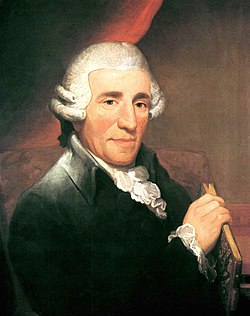
Joseph Haydn's Symphony No. 2 in C major, Hoboken I/2, is believed to have been written between 1757 and 1761.
It is scored for 2 oboes, bassoon, 2 horns, strings and continuo. [1] Like many of the earliest symphonies by Haydn and others of the time, it is in three movements:
In the second movement, the wind instruments are omitted and the violins play in semiquavers from start to finish (a kind of perpetuum mobile ) with the pattern frequently broken by the use of trills. [2] The violas in this slow movement double the bass part throughout at an octave above. [3] (e.g., "col basso," which was common in the period). Also, the first and second violins are the same in the second movement. The last movement is "Haydn's first attempt at a symphonic rondo and is characterized by a preoccupation with imitative processes." [4] It is the only one of Haydn's symphonies that contains no repeat signs. [5] It is also one of his shortest symphonies; performances generally last less than ten minutes.